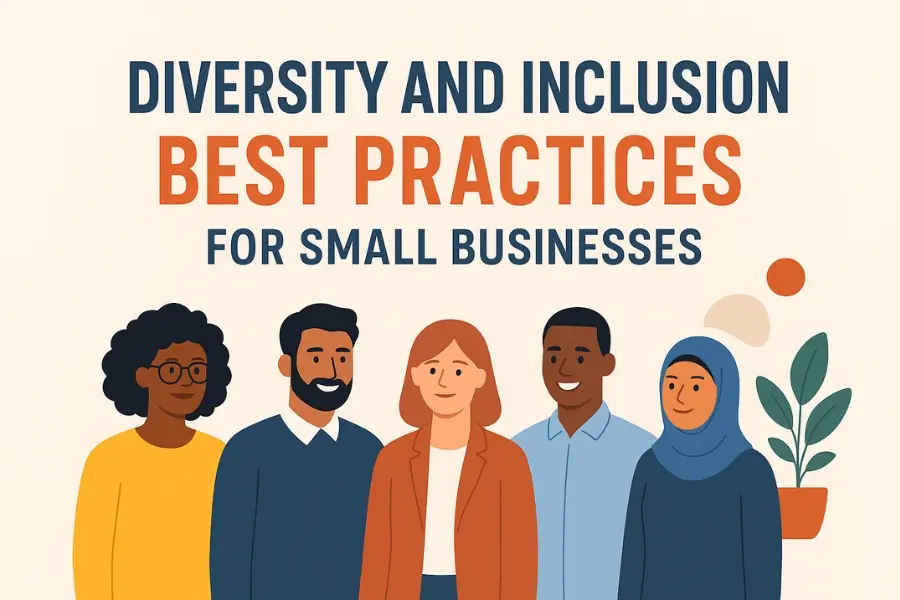Effective Diversity and Inclusion Best Practices Every Organisation Should Follow
Updated: 28 Sep 2025
What are Diversity and Inclusion Best Practices in small businesses? Diversity and inclusion (D&I) are essential components of modern business success. For small businesses, cultivating an inclusive culture not only strengthens employee engagement but also drives innovation, productivity, and long-term growth.
This comprehensive guide explores the best practices, strategies, and actionable steps to foster a truly inclusive workplace.

What Are Diversity and Inclusion Best Practices?
Diversity and Inclusion (D&I) best practices are simply the things organisations can do to make sure everyone feels welcome, respected, and able to contribute fully. It’s not just about hiring people from different backgrounds. It’s about creating an environment where differences are valued, voices are heard, and opportunities are fair for all.
Some of the Most Effective Practices
Here are some of the most effective practices in diversity and Inclusion Best Practices.
Lead by Example
Inclusion starts at the top. When leaders openly support D&I and hold themselves accountable, it sets the tone for the entire organisation.
Hire Fairly and Broadly
Write job descriptions that appeal to everyone, remove biased language, and make sure interview panels are diverse. Partner with groups that connect you to underrepresented talent.
Educate and Train
Offer workshops on unconscious bias, inclusive communication, and cultural awareness. The goal isn’t to shame, it’s to build understanding.
Review Policies with Fresh Eyes
Check if your pay practices are fair. Consider flexible work options and ensure that people with disabilities or other needs have access to the necessary support.
Support Employee Networks
Encourage groups where people with shared experiences (like women in leadership, LGBTQ+ employees, or multicultural teams) can connect and be heard.
Mind Your Language
Words matter. Use inclusive, respectful language in meetings, emails, and company materials.
Offer Growth Opportunities for All
Make sure everyone has access to mentorship, training, and promotion pathways—not just the “usual candidates.”
Track Progress, Not Just Promises
Collect data, set goals, and check in regularly to assess whether your efforts are yielding results.
Celebrate Differences
Acknowledge cultural holidays, encourage people to share their traditions, and incorporate them into the workplace culture.
Create Belonging
At the end of the day, inclusion means that people feel safe speaking up and know their voice matters.
Why It’s Worth It:
When people feel included, they bring their best ideas forward. Teams become more creative, employees stick around longer, and the company as a whole performs better. Beyond that, practising diversity and inclusion makes the workplace a more positive and human place to be.
In Short:
D&I best practices are about moving from having diversity on paper to building a culture of belonging.
1. How to Create an Inclusive Workplace Culture
Creating an inclusive workplace starts with a culture that values every employee. This includes fostering a sense of belonging, promoting equitable opportunities, and encouraging open communication.
Key Practices
- Leadership commitment: Leaders should demonstrate a commitment to inclusion through both their words and actions.
- Employee engagement: Actively seek input from diverse teams to shape policies.
- Transparent policies: Ensure rules and expectations are fair and consistently applied.
Creating an inclusive culture is a continuous journey of embedding fairness and respect into every decision, allowing small businesses to build workplaces where everyone thrives.
2. Strategies for Inclusion and Equity in Remote Teams
Remote teams present unique inclusion challenges. Small businesses must adapt strategies to ensure equity and belonging for virtual employees.
Key Strategies
- Regular check-ins: Schedule meetings to ensure everyone feels connected and engaged.
- Inclusive communication: Use accessible channels and provide clear guidelines.
- Equitable access to resources: Provide the tools needed for all employees to succeed remotely.
Equity in remote teams requires intentional effort; by prioritising communication and fairness, organisations can ensure every team member feels valued, regardless of their location.
3. How to Measure Diversity & Inclusion Success
Measuring Diversity and Inclusion (D&I) enables businesses to track progress and identify areas for improvement. Metrics should cover recruitment, retention, employee engagement, and equity outcomes.
Metrics to Track
- Workforce demographics
- Retention and promotion rates
- Pay equity
- Employee engagement and belonging scores
Measuring D&I is not just about numbers. It’s about leveraging insights to develop actionable strategies that promote long-term inclusion and growth.
4. Diversity Recruitment Best Practices for Startups
Recruiting diverse talent is a crucial first step in fostering an inclusive environment. Small businesses can implement strategies to attract underrepresented candidates.
Best Practices
- Widen candidate sourcing to include diverse networks
- Use inclusive language in job postings
- Implement structured, bias-free interviews
Recruitment practices lay the foundation for an inclusive workforce; hiring with intention ensures diversity is built into the organisation from the start.
5. How to Reduce Unconscious Bias in Hiring Processes
Unconscious bias can undermine equitable hiring. Recognising and mitigating bias ensures a fair selection process.
Strategies
- Blind resume screening
- Standardised interview questions
- Bias-awareness training for hiring teams
Reducing bias in hiring ensures every candidate is evaluated fairly, fostering a more diverse and equitable workplace.
6. Inclusive Leadership Qualities in Modern Organisations
Inclusive leaders model behaviours that encourage participation, fairness, and respect.
Key Qualities
- Empathy and active listening
- Accountability in decision-making
- Advocacy for underrepresented employees
Inclusive leadership shapes organisational culture, setting the tone for respect, collaboration, and innovation at every level.
7. Building Employee Resource Groups in Your Company
Employee Resource Groups (ERGs) provide opportunities for community, mentorship, and networking.
Implementation Tips
- Align ERGs with organisational goals
- Provide resources and leadership support
- Encourage cross-ERG collaboration
Employee Resource Groups create communities of support and amplify the voices of underrepresented individuals, thereby strengthening overall inclusion.
8. Examples of Successful Diversity & Inclusion Programs
Highlighting real-world programs can inspire small businesses to implement effective initiatives.
Examples
- Structured mentorship programs
- Inclusive onboarding initiatives
- Cultural awareness workshops
Learning from successful D&I programs provides a roadmap for implementing meaningful inclusion initiatives in your own organisation.
9. Inclusive Onboarding Process for New Hires
Onboarding sets the tone for inclusion. Ensure new hires feel welcomed and supported from day one.
Best Practices
- Assign mentors or buddies
- Share inclusive policies and resources
- Provide cultural orientation and sensitivity training
A thoughtful onboarding process ensures new hires feel welcomed, valued, and ready to contribute from day one.
10. How to Promote Belonging Among Diverse Employees
Belonging is critical for employee engagement and retention.
Strategies
- Celebrate diversity in teams
- Recognise contributions publicly
- Encourage employee feedback and involvement
Promoting belonging transforms diversity into a source of strength, fostering an environment where all employees can thrive.
11. Addressing Microaggressions in the Workplace
Microaggressions can undermine inclusion. Organisations must recognise and address these subtle biases.
Action Steps
- Educate employees about microaggressions
- Establish clear reporting mechanisms
- Provide training and follow-up support
Addressing microaggressions proactively fosters a safer and more respectful workplace for everyone.
12. Diversity Training Programs That Work
Effective diversity training programs go beyond compliance and foster cultural competence.
Features of Successful Programs
- Interactive workshops and role-play
- Continuous reinforcement
- Focus on practical skills and real-life scenarios
Effective diversity training empowers employees to actively participate in creating an inclusive culture.
The Importance of Diversity, Equity & Inclusion in the Workplace
13. Flexible Benefits to Support Workplace Inclusion
Flexible benefits demonstrate commitment to diverse employee needs.
Examples
- Remote work and flexible hours
- Parental leave and caregiving support
- Wellness programs catering to diverse lifestyles
Flexible benefits demonstrate that an organisation values its employees’ diverse lifestyles and needs.
14. Gender Diversity and Inclusion Strategies at Work
Promoting gender equity ensures that all employees have equal opportunities for advancement and growth.
Strategies
- Transparent pay bands and promotion criteria
- Mentorship and sponsorship for women leaders
- Family-friendly policies
Focusing on gender inclusion ensures equitable opportunities and strengthens organisational performance.
15. Racial Equity Initiatives in Corporations
Racial equity initiatives foster fair treatment and opportunities for employees of all backgrounds.
Examples
- Targeted recruitment pipelines
- Bias audits in promotions and pay
- ERGs for racial and ethnic minority groups
Racial equity initiatives ensure that all employees have fair access to opportunities and can thrive in the workplace.
16. Intersectional Inclusion Tips for HR Managers
Intersectionality recognises overlapping identities and ensures policies address multiple forms of discrimination.
Strategies
- Inclusive recruitment considering multiple identities
- Layered data analysis for hidden inequities
- Tailored training and benefits
Embracing intersectionality enables organisations to address complex challenges and develop more inclusive policies for all.
17. Creating Equity in Pay and Promotions
Equitable pay and promotion practices build trust and motivate employees.
Best Practices
- Regular pay audits
- Transparent salary bands
- Diverse promotion panels and mentorship
Equitable pay and promotions foster trust and motivate employees to perform at their best.
18. How to Implement Inclusive Decision-Making Frameworks
Inclusive decision-making ensures all voices are represented and valued.
Approaches
- Consensus-based models
- Deliberative dialogues
- Feedback integration and rotating roles
Inclusive decision-making ensures fair outcomes and empowers employees at all levels to contribute meaningfully to the organisation’s goals.
19. What Are Diversity & Inclusion Metrics to Track
Metrics guide organisations in assessing DEI success.
Key Metrics
- Recruitment representation
- Retention and promotion rates
- Pay equity
- Employee engagement and participation in ERGs
Metrics provide actionable insights to guide and improve ongoing diversity and inclusion efforts.
20. Leveraging Diverse Perspectives for Innovation
Diverse perspectives drive creativity and business innovation.
Strategies
- Inclusive brainstorming and cross-functional teams
- Psychological safety to share ideas
- Recognition of contributions from diverse employees
Leveraging diverse perspectives drives innovation and strengthens problem-solving across the organisation.
21. Cultural Competence Training in the Workplace
Training employees to navigate cultural differences enhances collaboration and inclusion.
Core Elements
- Awareness building and skill development
- Scenario-based learning
- Continuous reflection and evaluation
Cultural competence training equips employees to work effectively in diverse teams and fosters mutual respect.
22. Inclusive Communication Best Practices at Work
Inclusive communication ensures all employees feel respected and heard.
Best Practices
- Gender-neutral language
- Clear, jargon-free communication
- Accessible formats and multiple channels
Inclusive communication ensures every employee feels heard and valued, strengthening workplace cohesion.
23. Making Accessibility Part of Inclusion Efforts
Accessibility ensures employees with disabilities can fully participate in the workplace.
Strategies
- Physical accommodations and assistive technology
- Flexible policies and remote work options
- Ongoing evaluation and employee input
Accessibility initiatives make inclusion tangible, ensuring all employees can contribute fully.
24. Policies for Religious Inclusion in Companies
Inclusive policies respect employees’ faith and religious practices.
Strategies
- Flexible scheduling for religious observances
- Dress code accommodations
- Dietary considerations and prayer spaces
Respecting religious diversity builds trust and creates a respectful, supportive work environment.
25. Supporting Neurodiversity in the Workplace
Neurodiverse employees bring unique skills and perspectives.
Strategies
- Individualized accommodations
- Clear communication and task alignment
- Mentorship and awareness training
Supporting neurodiverse employees unlocks unique talents and promotes a more innovative workforce.
26. Inclusive Mentorship Programs for Underrepresented Employees
Mentorship empowers underrepresented employees to advance their careers.
Key Practices
- Structured mentor-mentee pairings
- Clear objectives and regular check-ins
- Training for mentors on inclusivity
Inclusive mentorship empowers underrepresented employees to reach their full potential and advance in their careers.
27. How Leadership Can Model Inclusion Behaviour
Inclusive leaders set the standard for organisational culture.
Key Behaviors
- Active listening and bias awareness
- Transparent communication
- Empowering and sponsoring underrepresented employees
Leaders who embody inclusion set the standard, inspiring the entire organisation to follow suit.
28. Challenges Implementing DEI Policies in Traditional Industries
Traditional industries face unique barriers to inclusion.
Strategies to Overcome Challenges
- Leadership buy-in and commitment
- Education and awareness programs
- Pipeline development and policy review
By understanding challenges and applying targeted strategies, even traditional industries can successfully implement DEI initiatives.
29. How to Avoid Tokenism When Promoting Diversity
Avoid tokenism by prioritising meaningful inclusion over appearances.
Key Practices
- Diverse representation beyond single individuals
- Meaningful participation in decisions
- Transparent objectives and accountability
Avoiding tokenism ensures that diversity initiatives are meaningful and create a lasting impact.
30. Creating Safe Spaces for Minority Groups at Work
Safe spaces promote psychological safety and a sense of belonging.
Strategies
- Employee Resource Groups (ERGs)
- Confidential forums
- Inclusive leadership support
Safe spaces empower minority employees to express themselves freely, contributing to a more inclusive culture.
31. Legal Compliance for Diversity & Discrimination Laws
Compliance ensures fair treatment and mitigates legal risk.
Key Steps
- Develop clear anti-discrimination policies
- Conduct employee training
- Maintain complaint mechanisms and documentation
Adhering to legal requirements safeguards employees and strengthens an organisation’s credibility in its diversity efforts.
32. How to Build Trust Through Diversity & Inclusion Efforts
Trust is foundational to effective DEI initiatives.
Strategies
- Transparent communication of goals and progress
- Consistency in policies and leadership behaviour
- Employee involvement and accountability measures
Trust is the foundation of any successful diversity and inclusion (D&I) initiative. Without it, even the best strategies cannot fully succeed.
Conclusion
Driving Lasting Impact Through Diversity & Inclusion
Diversity and inclusion are strategic imperatives that shape organisational culture, innovation, and long-term success. Implementing best practices across recruitment, leadership, pay equity, inclusive communication, accessibility, and employee support fosters a workplace where everyone feels valued and empowered.
Key Takeaways
- Inclusive culture strengthens engagement and retention
- Equity in pay and promotions builds trust
- Leadership behaviour sets the tone for inclusion
- Metrics and accountability ensure measurable impact
- Employee empowerment through safe spaces, mentorship, and accessibility enhances belonging
By committing to authentic, comprehensive, and values-aligned D&I efforts, organisations unlock the full potential of their workforce, drive innovation, and create workplaces where everyone truly belongs.
FAQs
In today’s workplace, understanding diversity and inclusion is essential for building a thriving, equitable organisation. Employees and leaders alike often have questions about how to implement effective diversity and inclusion (D&I) practices, measure success, and foster a truly inclusive culture. The following questions and answers offer practical insights and strategies to help small businesses and startups cultivate a more inclusive, equitable, and innovative workplace.
Diversity and inclusion best practices involve creating policies and a workplace culture that values and respects all employees, regardless of race, gender, age, disability, or background. For small businesses, this can include implementing equitable hiring practices, offering inclusive benefits, providing bias-awareness training, and fostering open communication. Encouraging employee participation in decision-making and celebrating cultural differences are also critical steps.
Final Thought: By adopting these practices, small businesses can create an inclusive environment that drives engagement, productivity, and innovation.
Creating an inclusive workplace culture starts with leadership commitment and clear communication. Policies should promote fairness, respect, and a sense of belonging. Encouraging employee feedback, providing mentorship programs, and celebrating diversity initiatives help foster a stronger sense of inclusion. Additionally, training managers on inclusive leadership skills ensures the culture is reinforced at all levels.
Final Thought: Fostering an inclusive culture is an ongoing journey, but the results are a more engaged and loyal workforce.
For remote teams, promoting equity requires regular communication, transparent processes, and equal access to resources. Using video check-ins, virtual collaboration tools, and ensuring recognition of all contributions helps maintain fairness and equity. Implementing structured performance evaluations and inclusive decision-making ensures that remote employees are not left out of opportunities.
Final Thought: Remote teams can thrive when equity is intentionally embedded in everyday practices.
D&I success can be measured through workforce demographics, pay equity audits, retention rates, employee engagement surveys, and participation in diversity programs. Tracking these metrics over time helps identify gaps and assess the effectiveness of policies and programs. Combining quantitative and qualitative feedback provides a holistic understanding of D&I outcomes.
Final Thought: Measuring D&I is not just about numbers. It’s about creating actionable insights that drive meaningful change.
Effective recruitment practices include posting job openings on diverse platforms, using inclusive language in job descriptions, conducting structured interviews, and minimising unconscious bias. Partnering with community organisations, attending diversity-focused career fairs, and building a pipeline of diverse candidates also improve recruitment outcomes.
Final Thought: Hiring with intention ensures that diversity becomes an integral part of the organisation’s growth.
Reducing unconscious bias involves implementing blind resume screening, standardised interviews, bias-awareness training for recruiters, and diverse interview panels. Encouraging objective evaluation and structured decision-making reduces the influence of stereotypes. Regular audits can also help identify and correct biased practices.
Final Thought: Tackling unconscious bias ensures a fairer and more equitable hiring process for all candidates.
Inclusive leaders demonstrate empathy, active listening, accountability, and advocacy for underrepresented employees. They encourage participation, value diverse perspectives, and make decisions transparently. Inclusive leaders model behaviours that reinforce equity and foster a culture of belonging.
Final Thought: Leaders who prioritise inclusion inspire their teams and create an environment where everyone can contribute meaningfully.
Employee Resource Groups (ERGs) provide a community for underrepresented employees to network, mentor, and share experiences. They also serve as advisory groups to influence company policies and drive diversity initiatives. ERGs enhance engagement, representation, and inclusion by giving employees a platform for their voices to be heard.
Final Thought: ERGs are a powerful tool for creating a sense of belonging and amplifying the voices of underrepresented individuals in the workplace.
Promoting belonging involves recognising contributions, encouraging collaboration, celebrating diversity, and providing safe spaces for dialogue. Organisations should also gather employee feedback, offer mentorship opportunities, and create policies that value and support all identities.
Final Thought: When employees feel they belong, engagement, performance, and retention improve significantly.
Challenges include resistance to change, limited resources, lack of leadership buy-in, and unconscious bias. Overcoming these requires education, transparent communication, leadership commitment, employee engagement, and regular monitoring of progress. Creating small, measurable goals can also help organisations gradually embed DEI into their culture.
Final Thought: With consistent effort and strategic planning, even challenging industries can successfully implement DEI initiatives.
Addressing diversity and inclusion challenges head-on empowers organisations to create lasting impact. By implementing best practices, reducing unconscious bias, fostering inclusive leadership, and promoting a sense of belonging, companies can unlock the full potential of their workforce. Continuous learning, measurement, and adaptation are key because a truly inclusive workplace is not just a goal but an ongoing journey.
- For bold: [b]text[/b]
- For italic: [i]text[/i]
- For underline: [u]text[/u]






